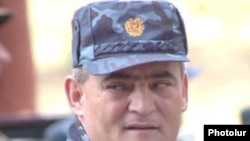“The police actions were legitimate. Perhaps they were not tough enough, but they were legitimate,” he told a parliamentary commission investigating the March 1, 2008 violence in Yerevan that left ten people dead and more than 200 others injured.
The clashes followed the dispersal of non-stop peaceful demonstrations organized in Yerevan’s Liberty Square by Levon Ter-Petrosian, the main opposition candidate in the disputed presidential election of February 2008. Thousands of Ter-Petrosian supporters barricaded themselves elsewhere in the city center in the following hours. Eight of them died in ensuing clashes with security forces. Two police servicemen were also killed in still unclear circumstances.
Harutiunian, who headed the police at the time, insisted that the police are not responsible for the bloodshed. “Responsibility fully rests with those who organized those disorders,” he said, referring to opposition leaders. He claimed that the latter intended to seize key government buildings in Yerevan.
The Armenian authorities have said all along that the Ter-Petrosian-led opposition provoked the clashes as part of a broader conspiracy to “usurp power” by force. More than 100 Ter-Petrosian supporters were arrested on related charges in the weeks following the worst unrest in the country’s history. More than 50 of them, including three parliament members, remain in jail.
Ter-Petrosian and his loyalists vehemently deny the coup allegations. They say that the authorities organized the “slaughter” to end massive street protests against what they see as a falsification of election results.
The official version of events has also been questioned by Armenia’s state human rights ombudsman as well as local and international rights watchdogs. In an extensive report released in February, the New York-based Human Rights Watch (HRW) deplored the “excessive use of force” by the Armenian police. “The fact that police were themselves under attack at times does not excuse those incidents where their own use of force was excessive,” said the report.
Harutiunian, who now runs another security agency charged with ensuring personal security of top state officials, stood by government claims that some of the protesters carried weapons but downplayed the fact that nobody has been prosecuted for firing at the police. He said that is the result of law-enforcement bodies’ “bad work” and a “good cover-up by the organizers of the mass riots.”
Harutiunian also insisted that security forces received no special orders to shoot at opposition protesters armed with sticks, iron bars, stones and Molotov cocktails. “If there was an order to open fire there would be thousands of casualties,” he said.
He argued that police officers that fought pitched battles with protesters did not need such orders because Armenia’s law on police allows them to use firearms whenever their life is at risk. “I want to stress that in such a situation police officers are allowed to use any object they have at hand,” he said.
